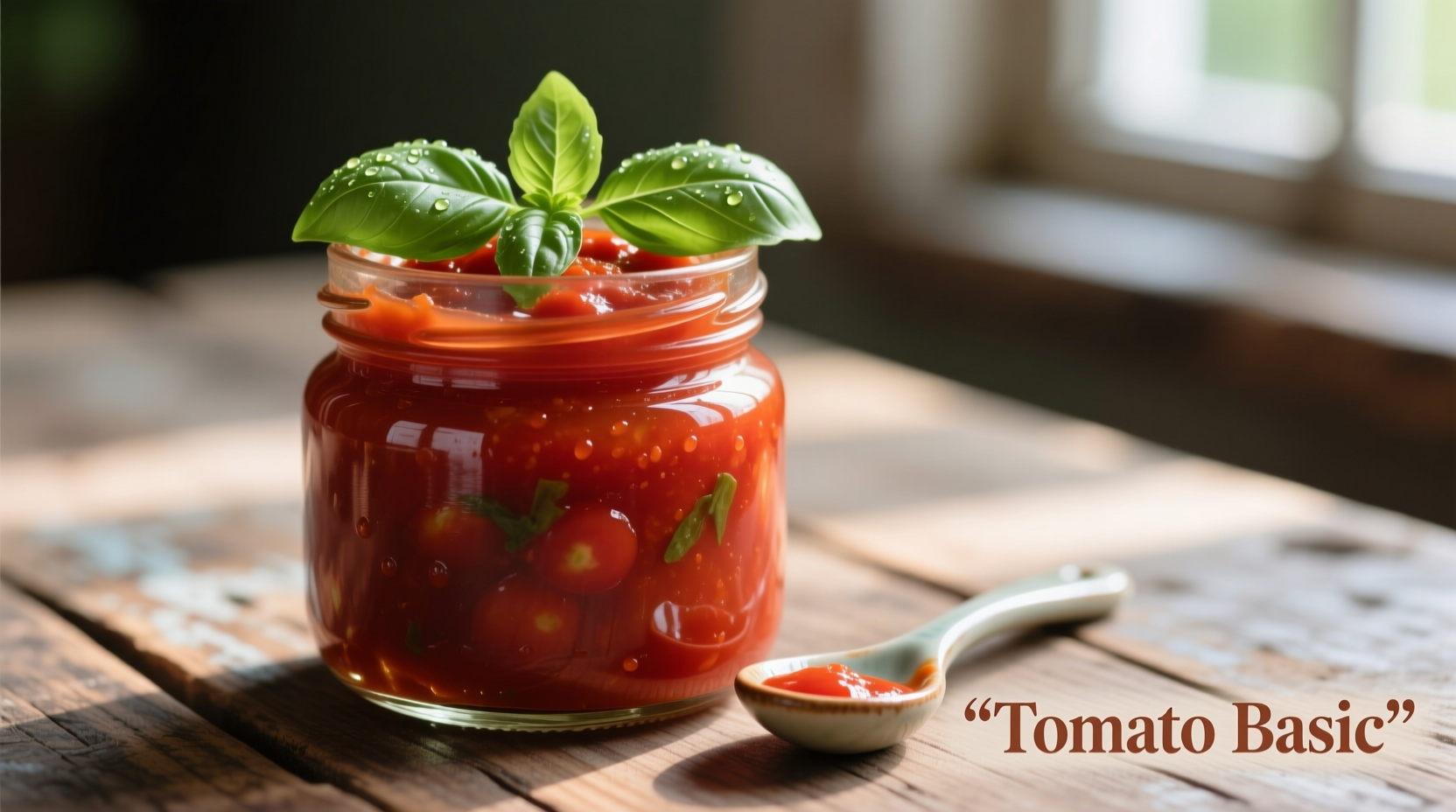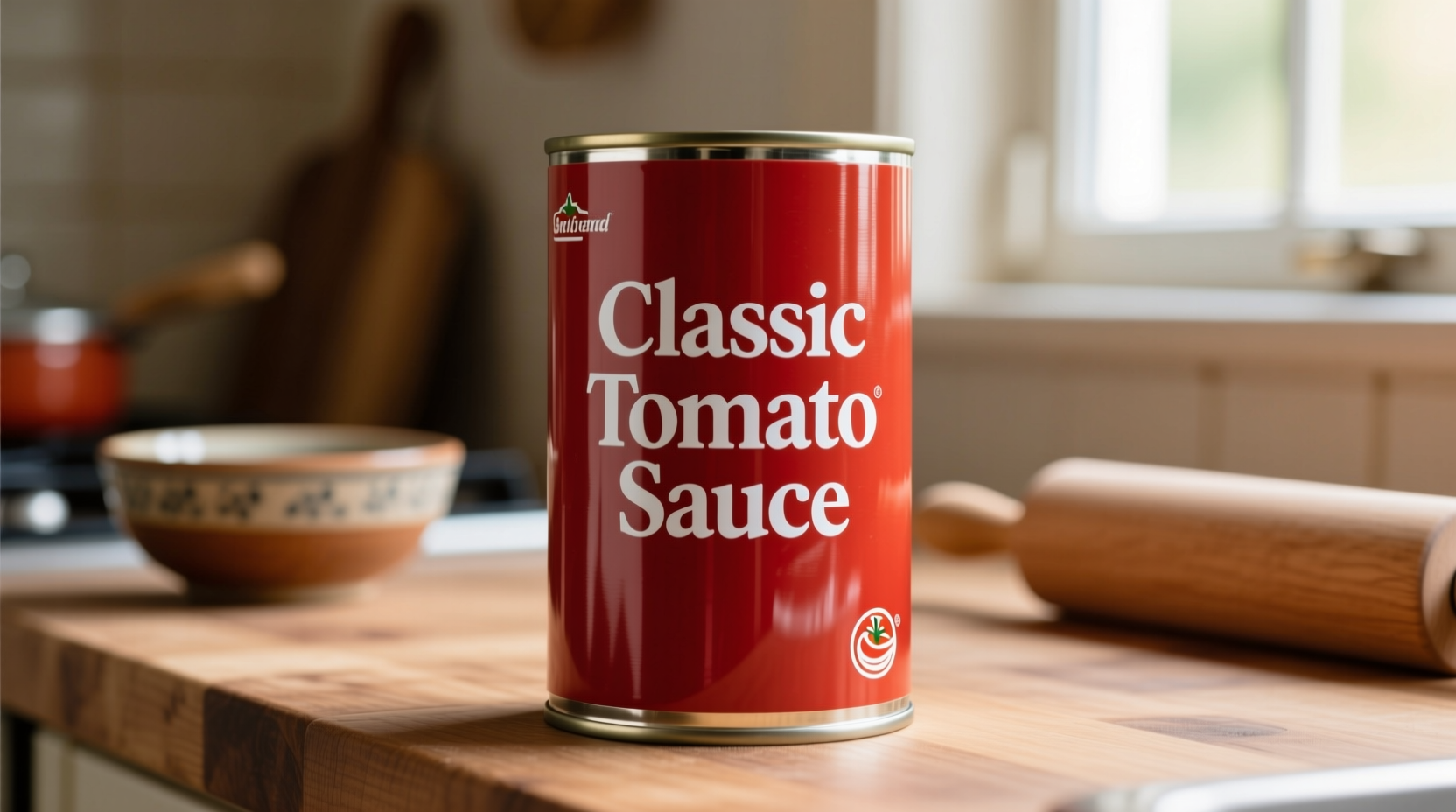A standard 15-ounce can of tomato sauce contains cooked tomatoes strained of skins and seeds, typically with added salt and citric acid for preservation. Unlike tomato paste, it has a thinner consistency perfect for sauces and soups, while lacking the herbs and seasonings found in marinara. Properly stored, unopened cans last 12-18 months in a cool, dry pantry.
Ever stared at that unassuming can of tomato sauce in your pantry wondering exactly what you're working with? You're not alone. Many home cooks confuse tomato sauce with similar products, leading to disappointing results in recipes. Understanding the precise characteristics of canned tomato sauce transforms how you use this kitchen staple.
What Exactly Is Canned Tomato Sauce?
Canned tomato sauce serves as the culinary foundation for countless dishes worldwide. Unlike fresh tomatoes, this product undergoes controlled cooking and straining processes that concentrate flavor while maintaining a smooth texture. The USDA defines commercial tomato sauce as "a liquid product prepared by cooking tomatoes, with or without the addition of water, salt, and citric acid" (USDA Standard 52-350.1).
| Tomato Product | Consistency | Ingredients | Best Uses |
|---|---|---|---|
| Tomato Sauce | Thin, pourable | Tomatoes, salt, citric acid | Base for soups, stews, braises |
| Tomato Paste | Thick, concentrated | 100% tomatoes | Flavor enhancer, small amounts |
| Marinara Sauce | Medium, chunky | Tomatoes, herbs, garlic, oil | Pasta dishes, dipping |
| Tomato Puree | Medium-thick | Tomatoes, salt | Thickening sauces, pizza bases |
Selecting Quality Canned Tomato Sauce
Not all tomato sauce cans deliver equal results. The FDA requires minimum tomato solids content of 8%, but premium products often contain 10-12%. When choosing between options, examine the ingredient list for unnecessary additives. High-quality brands typically contain only tomatoes, salt, and citric acid. Avoid products with sugar, preservatives, or artificial flavors unless your recipe specifically requires them.
Food scientists at Cornell University's Food Science Department note that tomato variety significantly impacts flavor profile. San Marzano tomatoes, grown in volcanic soil near Mount Vesuvius, produce sauce with naturally sweeter flavor and lower acidity compared to standard Roma varieties.
Proper Storage Techniques
Unopened cans maintain peak quality for 12-18 months when stored in cool, dry conditions below 75°F (24°C). The National Center for Home Food Preservation confirms that properly stored canned goods remain safe indefinitely, though flavor and texture degrade over time.
Once opened, transfer unused sauce to an airtight container and refrigerate. Most food safety experts, including those at the USDA Food Safety and Inspection Service, recommend consuming within 5-7 days. For longer storage, freeze portions in ice cube trays then transfer to freezer bags—this method preserves quality for up to 6 months.

Creative Culinary Applications
Move beyond basic pasta sauces with these professional chef techniques:
- Flavor base for soups: Use as foundation for minestrone, vegetable, or bean soups
- Meat braising liquid: Create tender short ribs or pot roast with tomato sauce, wine, and aromatics
- Breakfast transformation: Simmer with eggs for shakshuka or add to breakfast burritos
- Quick pizza sauce: Mix with Italian herbs and garlic for homemade pizza
- Vegetable enhancer: Toss with roasted vegetables for added moisture and flavor
Effective Substitutions When You're Out
Ran out of tomato sauce mid-recipe? These alternatives maintain dish integrity:
- Tomato puree: Use 1:1 ratio (slightly thicker but similar flavor)
- Diced tomatoes: Blend until smooth, then simmer 10 minutes to reduce liquid
- Tomato paste: Mix 1 part paste with 1 part water (creates thinner consistency)
- Marinara sauce: Use only if unseasoned—check label for added herbs
Remember that substitutions work best in cooked dishes where flavors meld. For raw applications like bruschetta, fresh tomatoes remain superior.
Nutritional Profile and Health Considerations
A 1/2 cup serving of plain tomato sauce provides approximately:
- 45 calories
- 27 mg sodium (1% DV)
- 3 grams fiber (12% DV)
- 18 mg vitamin C (20% DV)
- 16,000 mcg lycopene (powerful antioxidant)
Research published in the American Journal of Clinical Nutrition confirms that cooking tomatoes increases lycopene bioavailability by up to 35%. This antioxidant links to reduced risk of heart disease and certain cancers. Choose low-sodium varieties if monitoring salt intake, and always check labels for added sugars in flavored varieties.
Troubleshooting Common Issues
Fix these frequent tomato sauce problems:
- Too acidic: Add 1/4 teaspoon baking soda while simmering (neutralizes acid without altering flavor)
- Too thin: Simmer uncovered 10-15 minutes to reduce liquid
- Too thick: Gradually stir in vegetable broth or water
- Bland flavor: Sauté with garlic and onions before adding sauce
- Metallic taste: Indicates over-processing—add fresh herbs and a splash of red wine
Professional chefs recommend always tasting and adjusting seasoning after incorporating tomato sauce into your dish, as other ingredients affect the final flavor balance.
When Canned Tomato Sauce Isn't the Right Choice
Understanding context boundaries prevents recipe failures. Avoid substituting canned tomato sauce when:
- Creating fresh salsa or bruschetta topping (use fresh tomatoes)
- Making tomato soup from scratch (tomato puree provides better texture)
- Needing intense tomato flavor (tomato paste works better)
- Preparing raw sauces like arrabbiata (requires fresh garlic and chili)
Recognizing these limitations ensures your dishes achieve their intended flavor profiles and textures.
Frequently Asked Questions
Can I use tomato sauce instead of tomato paste?
Yes, but with adjustments. Simmer 1 cup tomato sauce until reduced to 1/4 cup to approximate tomato paste consistency. This concentration process restores the intense flavor profile needed for proper substitution.
How can I tell if canned tomato sauce has gone bad?
Check for bulging lids, leaking cans, or spurting liquid when opening. Once opened, spoiled sauce shows mold growth, off odors, or significant darkening. When in doubt, follow the USDA's recommendation: "When food safety is questionable, throw it out."
Is canned tomato sauce healthy?
Plain canned tomato sauce provides valuable nutrients like lycopene, vitamin C, and fiber with minimal calories. Choose low-sodium varieties and check for added sugars. The cooking process actually increases antioxidant availability compared to raw tomatoes.
Why does my tomato sauce taste metallic?
Metallic taste usually indicates over-processing or reaction with can lining. To fix this, add fresh herbs like basil or oregano, a splash of red wine, and simmer for 5-10 minutes. Using glass or stainless steel containers for storage prevents this issue.











 浙公网安备
33010002000092号
浙公网安备
33010002000092号 浙B2-20120091-4
浙B2-20120091-4